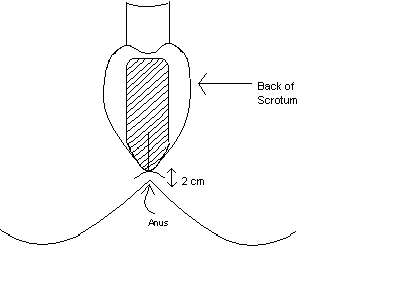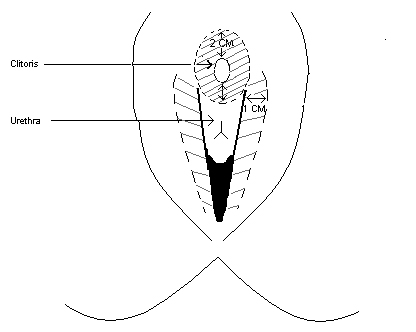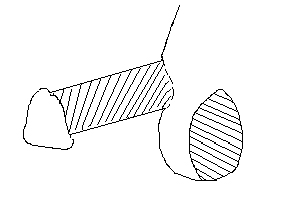Some vaginoplasty patients found that unremoved hair in and around their new vaginas caused problems during sex. Anyone who wants bottom surgery may want any donor skin to have any hair permanently removed well before surgery.
Ask your surgeon about what areas they want you to clear of hair prior to surgery. Each surgeon has different ideas.
Some people do not get permanent genital hair removal and don’t feel they needed it. Some surgeons can kill follicles in the donor tissue during surgery, but it can add time and money to the procedure.
Reasons for hair removal
- Surgeons may not need abdomen and hip skin grafts if a bottom feminization surgery patient cleared hair from the scrotum and penile base prior to surgery.
- You should plan for genital electrolysis to take about a year, although most get done sooner.
- It is possible to get genital electrolysis post-surgically, but treatment may be more difficult or impossible in certain areas.
Tips for better results
- Some hair removal practitioners may require a letter or phone call from your doctor or therapist indicating that genital electrolysis is necessary in preparation for a medical procedure.
- You may have to pay a higher hourly rate for genital electrolysis.
- You must be scrupulous about hygiene when getting genital electrolysis, especially if getting it performed close to your surgery date.
- Most people find genital electrolysis more painful than facial work. You may need to take additional steps to alleviate pain. Some have reported adequate pain relief with painkillers and/or EMLA, where others found injections necessary.
- Treatment should be done at the highest machine settings. Unlike your face, it doesn’t matter if you scar the skin slightly.
- Most surgeons recommend completing genital electrolysis one to six weeks before SRS. I recommend completing it at least six weeks before, and preferably 8 weeks before.
- Most SRS surgeons recommend waiting to begin genital electrolysis prior to labiaplasty until 6 to 8 weeks after vaginoplasty, and to complete it one to four weeks prior to labiaplasty.
- If you can’t afford to risk your time, money, or the quality of your surgical outcome on unproven technology, you should invest in the only proven permanent hair removal option: traditional electrolysis where a probe is inserted in the follicle.
- If you think it may be extremely painful for you, you may want to schedule a small test session at the end of a facial session before committing to a big block of time.
Before vaginoplasty
These diagrams show the typical areas surgeons suggest clearing before vaginoplasty.
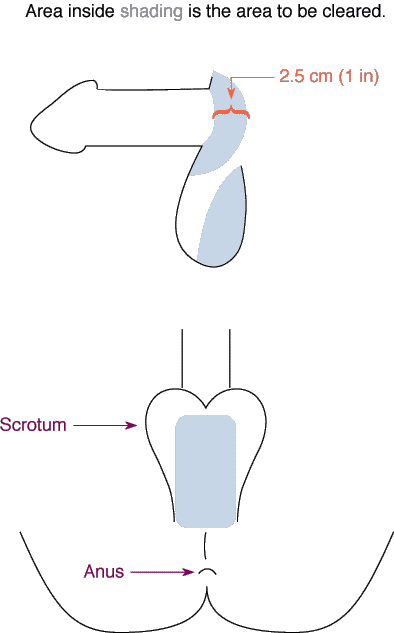
Before labiaplasty
If your surgeon does a two-stage bottom surgery, these areas should be cleared after vaginoplasty but before labiaplasty.
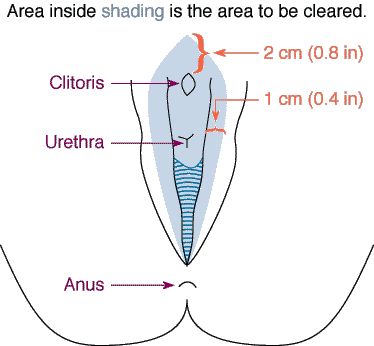
Toby Meltzer
American surgeon Toby Meltzer wrote in his 1998 information packet: “The penile skin is used to reline the vaginal vault, which eliminates the need for grafts in most cases. In patients with a shorter penis (less than five inches [12.7 cm] erect when measuring from the underside), distant grafts may still be avoided if the scrotum is cleared of hair preoperatively.”
Eugene Schrang
Retired American surgeon Eugene Schrang made these suggestions in 2002:
Hair can be removed by electrolysis or laser prior to surgery. But better still is the cutting away of the hair follicles while thinning the graft with scissors which can be done by me at the time of surgery followed by electrocoagulation of the follicles. This saves the patient time and money not to mention great discomfort from painful electrolysis. Since electrocoagulation is time consuming, we charge an extra $500 for this.
No matter what method is used to remove hair, the removal of ALL hair follicles is usually never completely accomplished and some hair may grow in the neo-vagina. This is why you must begin early to remove as much hair as possible from the scrotum if you wish me to use your scrotum as a full thickness graft and do not want me to remove the hair at surgery.
See also this diagram prepared by Dr. Schrang.
Pierre Brassard
Montreal surgeon Pierre Brassard wrote in their informational packet: “I perform the inversion technique. When the penis is too short, I use the excess skin from the scrotum to have sufficient amount of skin for the vaginoplasty. I am enclosing diagrams describing the technique used. Because I perform a perineal skin flap at the posterior end of the vagina, it is best to have electrolysis on this area. It is marked in the brochure (1 inch above the anus and an area of 1 inch X 1 inch).”
Michel Seghers
Retired surgeon Michel Seghers recommended removing the hair around the base of the penis and the hair on the midline 7 inches forward from the anus.
AEGIS (1995)
Medical advisory put out by Dallas Denny of the American Educational Gender Information Service (AEGIS).
AEGIS SUGGESTS ELECTROLYSIS TO AVOID PROBLEMS OF HAIR IN NEOVAGINA
The Problem
Vaginoplasty using the penile and penoscrotal inversion methods, with or without skin graft or skin flaps, can result in a neovagina which is lined with hair-bearing skin. As the hair grows, the vagina can become choked with hair. Not surprisingly, many transsexual women find this extremely embarrassing.
Some sex reassignment (SRS) surgeons do not appreciate the extent of this embarrassment. During a presentation given at the October, 1993 meeting of the Harry Benjamin International Gender Dysphoria Association, one prominent surgeon remarked that although his procedure sometimes results in hair-bearing vagina, his patients do not seem to mind. Reports we have had from transsexual women indicate, however, that they DO care.
Our Recommendations
We recommend that surgeons doing male-to-female SRS become aware that hair-bearing vagina is extremely embarrassing for their transsexual patients, and to provide them with materials educating them about the problem and indicating where they should consider having electrolysis to avoid hair-bearing vagina.
We recommend that electrologists be aware that transsexual women who are seeking SRS have legitimate reasons for seeking electrolysis in the perineal area.
We recommend that persons seeking male-to-female SRS who have excessive hair in the pelvic region consult with the surgeon they have selected in order to determine which skin will eventually be inside the vagina so that they can decide whether electrolysis is desirable and so they can schedule electrolysis and surgery accordingly.
All parties should keep in mind that electrolysis is a gradual process, and that it can take a year or more to completely clear an area.
While most electrologists will do this for clients they have treated for a while, many will balk if you approach them with this request first. Besides, you should begin with your face anyway, which will take longer than any genital work you may need. For most electrologists, hair is hair, and they’re used to working around women’s bikini lines. However, if you run into some resistance, you may need to get a letter or phone call from your doctor or therapist indicating that genital electrolysis is necessary in preparation for a medical procedure.
Looking Glass Society
Many don’t get it and don’t feel they needed it. A trans client will probably feel intensely embarrassed about merely possessing male genitalia, let alone allowing someone else to see them. However, it must be said that genital electrolysis contributes greatly to a satisfactory outcome of the surgery… Hygiene before and after treatment is paramount, as there is a high risk of skin infections from genital electrolysis. Some clients report using Betadine liquid to good effect, before and after genital electrolysis.
The skin itself is soft, wrinkled and rubbery in texture, and the follicles can be very ‘tight’ in some clients. Careful attention to stretching the skin around the follicle being treated is essential, and some electrologists find a relatively stiff needle, such as some of the one-piece designs, helpful as it may be necessary to push the needle into the follicle considerably more forcefully than with any other site on the body, and a highly flexible two-piece needle may be prone to bending.
Practitioner comment (2001)
I mentioned to you once before that I do genital electro. I just completed my 24th clearance and have had a problem with her I thought was a one of before.
I have encountered a possible problem with it. On two people I have had a section of skin where the scrotum joins the penile skin being damaged and healing a lot slower after high power treatment with electro and four people who have had a longer healing time for that area that any other part of the genital area.
The last person the skin didn’t scab over for almost two weeks and kept weeping from a point in that area about 1cm square.
The rest of the genital area that was done healed very quickly as usual.
I usually do the genital electro under local anesthetic and treat hairs in that area differently from the face. I set the machine at very high settings.
The skin at the top of the basis of the penis heals very fast and very well in my experience.
Scrotal tissue on the other hand I have noticed tends to heal a lot slower in some people. It may be an idea to warn people about this in your genital electrolysis section
I would suggest people be informed that they really have to have had the last session about 8 weeks before there operation in case a complication like this occurs as it could take a month to clear up.
Resources
James Bellringer (genderxchange.com)
- Hair removal (includes image of recommended treatment area)
